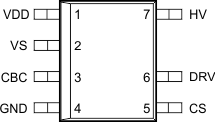SLUSBE8B May 2013 – September 2015 UCC28720
PRODUCTION DATA.
- 1 Features
- 2 Applications
- 3 Description
- 4 Revision History
- 5 Pin Configuration and Functions
- 6 Specifications
- 7 Detailed Description
-
8 Application and Implementation
- 8.1 Application Information
- 8.2
Typical Application
- 8.2.1 Design Requirements
- 8.2.2
Detailed Design Procedure
- 8.2.2.1 Stand-by Power Estimate
- 8.2.2.2 Input Bulk Capacitance and Minimum Bulk Voltage
- 8.2.2.3 Transformer Turns Ratio, Inductance, Primary-Peak Current
- 8.2.2.4 Transformer Parameter Verification
- 8.2.2.5 Output Capacitance
- 8.2.2.6 VDD Capacitance, CDD
- 8.2.2.7 VS Resistor Divider, Line Compensation, and Cable Compensation
- 8.2.3 Application Curves
- 9 Power Supply Recommendations
- 10Layout
-
11Device and Documentation Support
- 11.1
Device Support
- 11.1.1
Device Nomenclature
- 11.1.1.1
Definition of Terms
- 11.1.1.1.1 Capacitance Terms in Farads
- 11.1.1.1.2 Duty Cycle Terms
- 11.1.1.1.3 Frequency Terms in Hertz
- 11.1.1.1.4 Current Terms in Amperes
- 11.1.1.1.5 Current and Voltage Scaling Terms
- 11.1.1.1.6 Transformer Terms
- 11.1.1.1.7 Power Terms in Watts
- 11.1.1.1.8 Resistance Terms in Ω
- 11.1.1.1.9 Timing Terms in Seconds
- 11.1.1.1.10 Voltage Terms in Volts
- 11.1.1.1.11 AC Voltage Terms in VRMS
- 11.1.1.1.12 Efficiency Terms
- 11.1.1.1
Definition of Terms
- 11.1.1
Device Nomenclature
- 11.2 Documentation Support
- 11.3 Community Resources
- 11.4 Trademarks
- 11.5 Electrostatic Discharge Caution
- 11.6 Glossary
- 11.1
Device Support
- 12Mechanical, Packaging, and Orderable Information
5 Pin Configuration and Functions
D PACKAGE
7-PIN SOIC
Top View

Pin Functions
| PIN | I/O | DESCRIPTION | |
|---|---|---|---|
| NAME | NO. | ||
| VDD | 1 | I | VDD is the bias supply input pin to the controller. A carefully-placed bypass capacitor to GND is required on this pin. |
| VS | 2 | I | Voltage sense is an input used to provide voltage and timing feedback to the controller. This pin is connected to a voltage divider between an auxiliary winding and GND. The value of the upper resistor of this divider is used to program the AC-mains run and stop thresholds and line compensation at the CS pin. |
| CBC | 3 | I | Cable compensation is a programming pin for compensation of cable voltage drop. Cable compensation is programmed with a resistor to GND. |
| GND | 4 | — | The ground pin is both the reference pin for the controller and the low-side return for the drive output. Special care must be taken to return all AC decoupling capacitors as close as possible to this pin and avoid any common trace length with analog signal return paths. |
| CS | 5 | I | Current sense input connects to a ground-referenced current-sense resistor in series with the power switch. The resulting voltage is used to monitor and control the peak primary current. A series resistor can be added to this pin to compensate the peak switch current levels as the AC-mains input varies. |
| DRV | 6 | O | Drive is an output used to drive the base of an external high voltage NPN transistor. |
| HV | 7 | I | The high-voltage pin connects directly to the rectified bulk voltage and provides charge to the VDD capacitor for start-up of the power supply. |